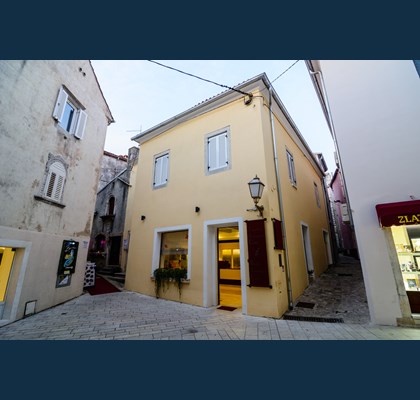Style period: baroque, classicism
Century: 19
A.D.
At the very beginning of the main city street, near the Vela Placa (Great Market), there is an edifice which used to contain the Algarotti collection. Today this object houses the Tourist Information Centre.
The Algarotti collection is a collectionary venture by the Krk priest Nikola Udine Algarotti (1791 – 1838), which consists of three parts, the library with about 6000 books, the collection of music manuscripts with about 3300 pieces of sheet music, manuscripts and printed matter, as well as sixteen stringed instruments, some of which are the works of famous European instrument builders. Algarotti died in Vienna, as the rector of the church of St Anna. His legacy, which he left to the city, was transferred to Krk in 1840, and already on 6 January 1842 the first public library in Krk was opened in the building of the former shop.
Library:
The diligent keepers and cataloguers have so far singled out three incunabulae (books printed before 1500) and about a hundred books printed in the 16th century from the rather large fund of about 6000 books. Besides the most numerous books with theological, philosophical and liturgical character, there is a significant number of books of ancient classical literature, as well as newer classics written in Italian, French, German and English language. The library is adorned by dozens of old Croatian books, printed in the 18th and the 19th centuries.
The collection also contains a manuscript fund, the oldest of which is the recipe for making ink from the 14th century.
Music manuscripts:
The rich collection of about 3300 volumes of sheet music and literature about music witness about Algarotti’s love of music. The most valuable part of the music manuscript collection are the autographs by the composers, Giulio Bajamonti and other composers from Split from the Split phase (1814 – 1818), to Ljubljana and Kranj composers (Anton Höller, Wenzel Wratny, F.B. Dussek, L.F. Schwerdt…), to the ones from Salzburg and Vienna (Michael Haydn, Georg Schinn, Benedikt Hacker, Franz Geissler…). There is also a significant number of valuable first editions of music pieces of the then composers, among which we should point out Leopold and Wolfgang Amadeusa Mozart, L. van Beethoven, A. Salieri, etc.
Collection of instruments:
Among the eleven violins, made from the beginning of the 17th until the 19th century, most carry the signatures of some of the greatest European stringed instrument builders of the time: Antonio Amati, Mathias Albani, Carlo Bergonzi, Giovanni Battista Guadagnini, Francesco Rugeri, Goffredo Cappa, Jacob Stainer, Vincenzo Vinaccia, Johann Joseph Stadelmann. Expert evaluations have so far confirmed the authorship of Jacob Steiner over the violin made in 1654, G. B. Guadagnini with the assumption that the instrument was made in 1765, and the authorship of A. Amati over the violin from 1619, M. Albani (1702), C. Bergonzi (1734) and J. J. Stadelmann await their confirmation through further research.
The attributions to Rugeri, Cappino and Steiner (1667) were discarded, but this does not dispute the value and age of the instruments in question. The important thing now is to attribute them properly.
Among the four violas, the oldest and the most interesting one dates back to 1563, the work is signed by Fecit Simon da Forli ao 1563. Below the signature, there is the inscription Reparavit J. Stöhr Ao 1830. The signed restorer was probably an acquaintance of Algarotti, as they operated in Vienna at the same time. This viola is also the oldest instrument in the collection.
The following viola according to age, and a cello, were said to have been made by Jacob Steiner in Absam near Innsbruck (Absam prope Oenipontem) in 1663 and 1664.
One viola is the work of Joseph Pauli in Linz in 1797. As Pauli lived in Vienna at the same time as Algarotti, they might have been acquaintances.
The origin of the viola signed by Paolo Perantoni… Napoli A. 1785 has not been determined yet.
Originally, the collection was richer by a few valuable instruments; however, they disappeared without a trace.
Bibliography:
- Katalinić, Vjera, Velčić, Franjo, Žgaljić, Josip, Nikola Udina Algarotti, Grad Krk-Glosa Rijeka, 2010.
- Spicijarić, Nina, Nikola Udina Algarotti (Krk, 1791. – Beč, 1838.), muzikolog, filolog, prevoditelj, Rijeka, 15/1, Povijesno društvo Rijeka, 2010.

